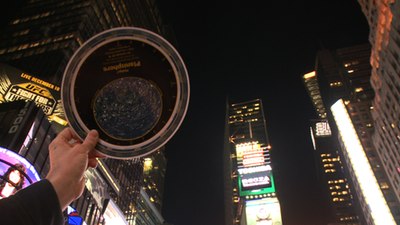Review: The City Darkby Jeff Foust
|
| Cheney interviews people who suggest we lose a sense of wonder about the cosmos, and perhaps a degree of humility as well, when we’re deprived of the night sky. |
Filmmaker Ian Cheney had the opposite experience. Growing up in rural Maine, he was used to seeing the night sky in its full glory. However, he lost that view once he moved to New York City, whose denizens are better able to see entertainment stars than astronomical ones. That loss of the night sky, and its implications for society, spurred him to produce and direct the documentary The City Dark. The film, which premiered last March at the South by Southwest festival in Austin, Texas, has been on the festival circuit since then, as well as a brief theatrical run last month in New York; it was also screened at last month’s meeting of the American Astronomical Society in Austin.
Cheney’s study of the effects of light pollution on humanity and nature start in New York, where he explores the challenges of observing the night sky from Times Square and elsewhere in the metropolis. From there he crisscrosses the country, offering little vignettes of what it means to observe—and lose—the night sky. He visits a “dark sky” community in Arizona where residents are united in their love of stargazing; astronomers in Hawaii looking for potentially hazardous near Earth objects, who worry about the encroaching effects of light pollution on their observations; and biologists on Florida beaches who try to save newborn sea turtles disoriented by the artificial lights of communities that have sprung up along the coast. He even goes as far to suggest in the film that light pollution might be linked to increased incidences of breast cancer among night-shift workers, although the film admits there’s as yet no evidence of any causation for that correlation.
There may be a more fundamental reason for appreciating the night sky, though, he suggests in the film. Cheney interviews people such as Ann Druyan and Neil deGrasse Tyson, who suggest we lose a sense of wonder about the cosmos, and perhaps a degree of humility as well, when we’re deprived of the night sky. “It’s kind of a resetting of your ego,” Tyson says of looking at the sky. That may be true now more than ever, as discoveries in recent years have made it clear that solar systems are relatively common—and thus, perhaps, so is life. The City Dark examines some of the efforts to mitigate light pollution, but even those measures make it unlikely residents of cities will be able to appreciate the night sky in the same way as Cheney did in his rural Maine home. However, this film, like my glance out the car window on a Nebraska night years ago, makes you better appreciate what you’re missing.
